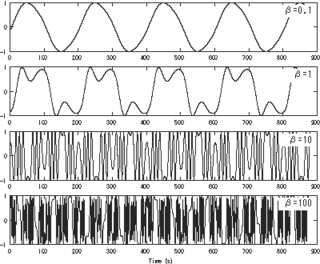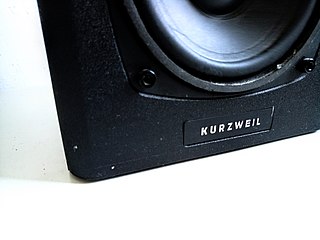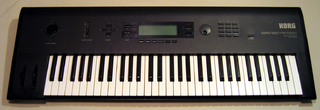
Frequency modulation synthesis is a form of sound synthesis whereby the frequency of a waveform is changed by modulating its frequency with a modulator. The (instantaneous) frequency of an oscillator is altered in accordance with the amplitude of a modulating signal.

The Yamaha DX7 is a synthesizer manufactured by Yamaha Corporation from 1983 to 1989. It was the first successful digital synthesizer and is one of the best-selling synthesizers in history, selling more than 200,000 units.
The Ensoniq Mirage is one of the earliest affordable sampler-synths, introduced in 1984 as Ensoniq's first product. Introduced at a list price of $1,695 with features previously only found on more expensive samplers like the Fairlight CMI, the Mirage sold nearly 8,000 units in its first year - more than the combined unit sales of all other samplers at that time. The Mirage sold over 30,000 units during its availability.

Novation Digital Music Systems Ltd. is a British musical equipment manufacturer, founded in 1992 by Ian Jannaway and Mark Thompson as Novation Electronic Music Systems. Today the company specializes in MIDI controllers with and without keyboards, both analog and virtual analog performance synthesizers, grid-based performance controllers, and audio interfaces. At present, Novation products are primarily manufactured in China.

Ensoniq ESQ-1 is a 61-key, velocity sensitive, eight-note polyphonic and multitimbral synthesizer released by Ensoniq in 1985. It was marketed as a "digital wave synthesizer" but was an early Music Workstation. Although its voice generation is typically subtractive in much the same fashion as most analog synthesizers that preceded it, its oscillators are neither voltage nor "digitally controlled", but true digital oscillators, provided by a custom Ensoniq wavetable chip. The signal path includes analog resonant low-pass filters and an analog amplifier.

Kurzweil Music Systems is an American company that produces electronic musical instruments. It was founded in 1982 by Stevie Wonder (musician), Ray Kurzweil (innovator) and Bruce Cichowlas.
The Yamaha AN1x is a DSP-based analog modeling synthesizer, produced by Yamaha Corporation from 1997 to 1998, and was marketed as an "analog physical modelling control synthesizer".
The Yamaha TX81Z is a rack-mounted (keyboard-less) frequency modulation (FM) music synthesizer, released in 1987. It is also known as a keyboard-less Yamaha DX11. Unlike previous FM synthesizers of the era, the TX81Z was the first to offer a range of oscillator waveforms other than just sine waves, conferring the new timbres of some of its patches when compared to older, sine-only FM synths. The TX81Z has developed a famous reputation, largely based on some of its preset bass sounds. The Yamaha DX11 keyboard synth was released the following year, offering improved editing abilities.

The Korg Wavestation is a vector synthesis synthesizer first produced in the early 1990s and later re-released as a software synthesizer in 2004. Its primary innovation was Wave Sequencing, a method of multi-timbral sound generation in which different PCM waveform data are played successively, resulting in continuously evolving sounds. The Wavestation's "Advanced Vector Synthesis" sound architecture resembled early vector synths such as the Sequential Circuits Prophet VS.
The Yamaha SY85 is a digital music workstation introduced in 1992. Unlike other Yamaha synthesizers of the time the SY85 does not use FM synthesis. Instead, its sounds are based on samples, which can be layered and modified to create new sounds.
The Yamaha V50 is a hybrid music workstation introduced in 1989. It combines a sequencer, rhythm machine, an FM synthesis-based sound module and a MIDI keyboard.

Yamaha SY77 is a 16 voice multitimbral music workstation first produced by Yamaha Corporation in 1989. The SY77 is a synthesizer whose architecture combines AFM synthesis, AWM2 for ROM-borne sample-based synthesis, and the combination of these two methods christened Realtime Convolution and Modulation Synthesis (RCM). The same technology was also packaged in a rack-mounted module released simultaneously, the TG77.
The Yamaha FS1R is a sound synthesizer module, manufactured by the Yamaha Corporation from 1998 to 2000. Based on Formant synthesis, it also has FM synthesis capabilities similar to the DX range. Its editing involves 2,000+ parameters in any one 'performance', prompting the creation of a number of third party freeware programming applications. These applications provide the tools needed to program the synth which were missing when it was in production by Yamaha. The synth was discontinued after two years, probably in part due to its complexity, poor front-panel controls, brief manual and limited polyphony.
The Yamaha SY99 is a synthesiser combining frequency modulation synthesis and sample-based synthesis and the direct successor to Yamaha's SY77/TG77. Compared to the SY77, it has a larger keyboard at 76 keys instead of 61, a larger ROM with more in-built AWM samples, the ability to load user-specified AWM samples into on-board RAM, an upgraded effects processor, and several other enhanced features.

The Yamaha DX1 is the top-level member of Yamaha's prolific DX series of FM synthesizers.

The CZ series is a family of low-cost phase distortion synthesizers produced by Casio in the mid-1980s. Eight models of CZ synthesizers were released: the CZ-101, CZ-230S, CZ-1000, CZ-2000S, CZ-2600S, CZ-3000, CZ-5000, and the CZ-1. Additionally, the home-keyboard model CT-6500 used 48 phase distortion presets from the CZ line. The CZ synthesizers' price at the time of their introduction made programmable synthesizers affordable enough to be purchased by garage bands. Yamaha soon introduced their own low-cost digital synthesizers, including the DX-21 (1985) and Yamaha DX100, in light of the CZ series' success.

The Yamaha DX21 is a digital controlled bi-timbral programmable digital FM synthesizer with a four operator synth voice generator which was released in 1985. It uses sine wave-based frequency modulation (FM) synthesis. It has two FM tone generators and a 32-voice random-access memory (RAM), 32 user voices and 128 read-only memory (ROM) factory preset sounds. As a programmable synth, it enables users to create their own unique synthesized tones and sound effects by using the algorithms and oscillators. The instrument weighs 8 kg (17.6 lbs). On its release, it sold for $795.
The Yamaha DX9 is a spin off synthesizer of the family of the DX7 built by Yamaha. It uses FM synthesis and has 16 note polyphony; however, it only has four FM operators for sound generation compared with six on the DX7. It is the least complex of the DX range of synthesizers and has only 20 on board memory locations.
The Yamaha PTX8 is a digital sample-based percussion tone generator built by Yamaha, in late 1986. It was included in the Yamaha D8 electronic drum kit.











